New Zealand Dollar Set to Weaken, Say BNZ, Though Counterarguments Compelling
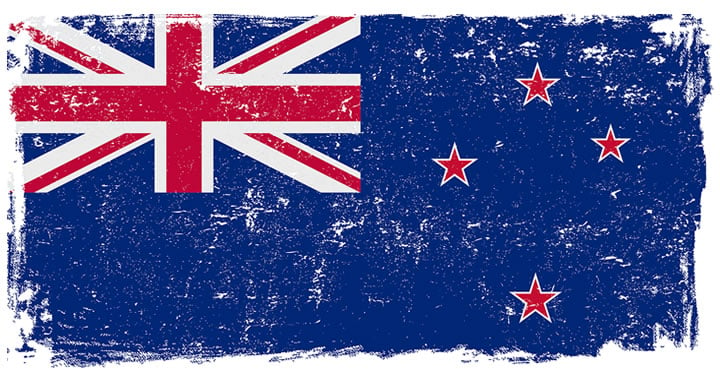
The New Zealand Dollar to US Dollar has stalled at a key trendline at 0.7300 and now analysts at BNZ bank see the pair rotating and falling as the New Zealand Dollar (Kiwi) loses ground due to a negative fundamental backdrop.
The pair has just touched and marginally broken above the trendline connecting the key October 2016 and January 2017 highs.
Weakness is not just expected versus the Dollar but across the board, with NZD/EUR expected to experience the deepest loses and NZD/GBP also likely to weaken despite Sterling’s own headwinds.
The view is very similar to that expressed by analysts at Morgan Stanley which we covered recently on PSL, who also point to the overhead resistance from the same trendline as constituting a line in the sand for the pair, and envision a reversal and new phase of Kiwi weakness on the horizon.
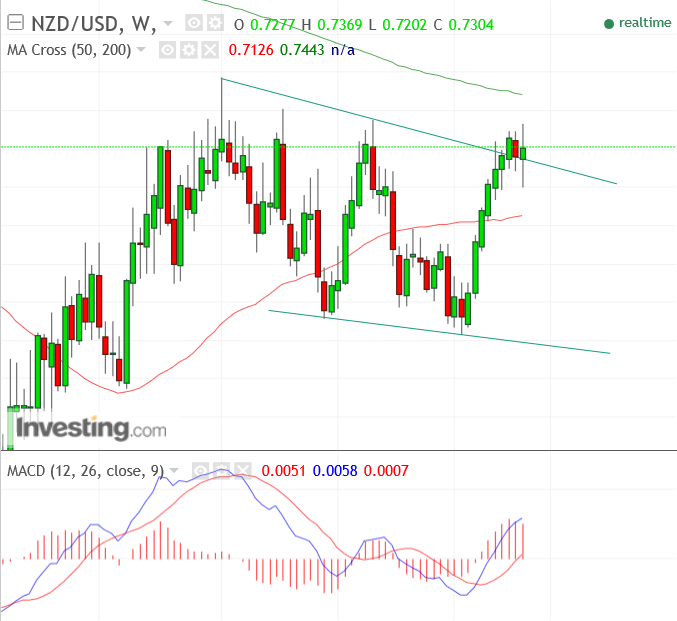
New Zealand lender BNZ sees several fundamental reasons for the Kiwi to weaken which combined with the ‘glass’-ceiling of the trendline add up to a bearish argument for the currency.
The main thrust of the argument against the Kiwi is that there is no fundamental reason for it to rise anymore.
The Kiwi was grossly undervalued at more than -8% in May but it has made up lost ground since then and is now only -3% undervalued which is within the margin of error for fair-value models.
The New Zealand Dollar has seen a marked rise in popularity from big speculators or ‘smart money’ investors as reflected in currency futures positioning from US futures exchanges.
Indeed, it has reached such a level now that the currency appears ‘overbought’ or “lop-sided” and more inclined to pull-back than continue rising.
“This lop-sided positioning has created a hurdle for the NZD to make any further progress beyond the 0.73 handle,” commented Toplis.
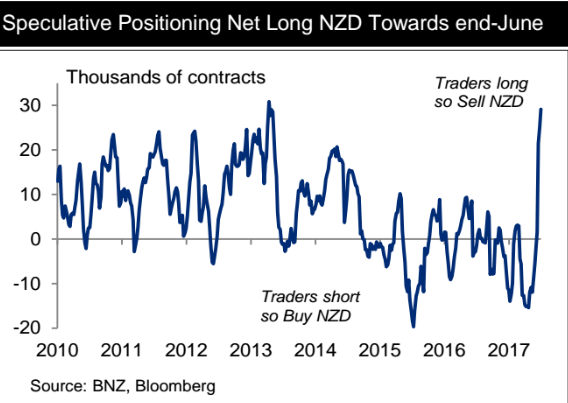
Research has shown that the Kiwi is highly sensitive to US Treasury yields with which they have a high negative correlation.
This means that when US yields rise the Kiwi falls and vis-versa.
“When we look at correlations, the usual NZD drivers have a much lower than usual correlation with the NZD at present. One exception is US 10-year Treasury yields, which have had a greater than usual (inverse) correlation with the NZD since the beginning of the year,” said Toplis.
Notwithstanding recent moribund inflation and falling Retail Sales data out of the US today (Friday, July 14), the outlook probably still remains relatively hawkish for US interest rates, which means the expectation remains for them to rise.
If this comes to pass then that would be another fundamental driver lower for the Kiwi.
However, if this is the start of a deeper retrenchment by the US economy then a very different interpretation could be applied to the data, a point which we will revisit later in the article when we look at the opposite argument.
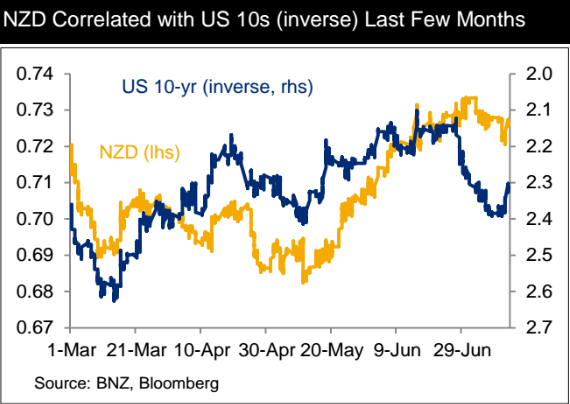
Another argument for the NZD falling is the stubbornly neutral stance of the RBNZ and their fear of a stronger Kiwi.
This combined with the post-Sintra view that most world central banks are moving towards dismantling stimulus schemes and eventually raising interest rates leads to expectations that the NZD’s interest rate advantage will diminish over time.
The higher interest rate in New Zealand, currently at 1.75% but previously much higher, has aided the Kiwi by attracting flows from investors wanting to park their money and watch it grow at a faster rate, however, now the advantage has fallen, especially versus the USD the incentive is not as great and NZD is expected to weaken as a result.
“The combination of global central banks moving towards less policy accommodation and the RBNZ sitting on its hands should encourage narrower NZ-global yield spreads and be a headwind for the NZD for the rest of the year,” said Toplis.
In relation to this, next Tuesday’s Q2 CPI release could be key, although Toplis expects it to be, “supportive of the RBNZ’s stance,” and to reveal that, “the recent rise in headline inflation was simply driven by temporary factors.”
Forecasts
BNZ forecast a broad-based decline in the New Zealand Dollar, with NZD/USD reaching USD 0.7100 at end of Q3 and end-Q4 target of USD 0.68. The current level is 0.7300.
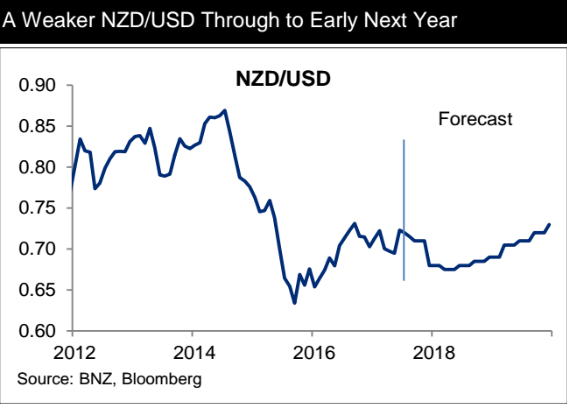
BNZ is especially bearish about NZD/EUR, which although at 0.6390 currently, is forecast to weaken to 0.59 by the end of 2017 and 0.56 by the end of next year.
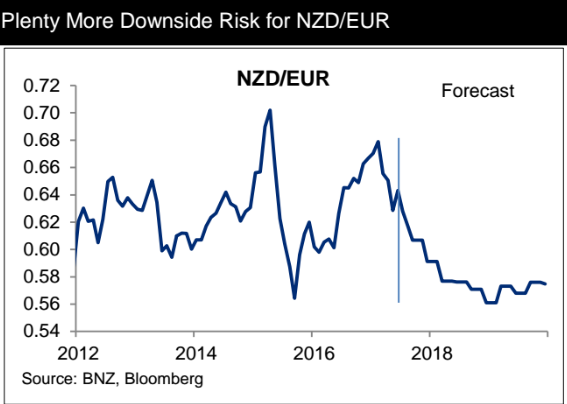
Despite Sterling remaining vulnerable from political uncertainty and risk over Brexit BNZ still expects the Kiwi to also weaken versus the Pound.
NZD/GBP is at 0.5630 currently and whilst they do not see the Bank of England increasing the official rate until early next year, and a dataflow potentially “taking a turn for the worse” they nevertheless, see talk of tighter monetary policy supporting the pound and
NZD/GBP is now projected to fall to around 0.53-0.54, before support sets in.
Counterarguments
One positive for the currency has been improving terms of trade and commodity prices, however, these have not been an driving force on a daily basis recently.
Yet they may become so – and if Dairy prices continue to trend higher as they have over recent months this should feed through as support for the Kiwi.
Another potential issue for NZD/USD, in particular, is the recent run of poor data in the US, which saw the Dollar weaken after the release of weak Retail Sales and Inflation data on Friday.
Janet Yellen’s recent cautious rapprochement is also a negative sign for the Dollar as it suggests the Fed could slow down the pace of rate hikes.
If this happens US ten-year yields to which the Kiwi is so highly inversely correlated are likely to fall steeply, leading to an appreciation in NZD.
The argument that the exchange rate is likely to pull-back now too after touching resistance from the long-term trendline at 0.73 has also now been thrown into doubt by the fact that the pair has now actually broken slightly above the sloping trendline and may have actually just completed a bullish break higher.
Such a break, as illustrated in the chart below could be a precursor for more upside, in fact, rather than downside, from a technical point of view.





